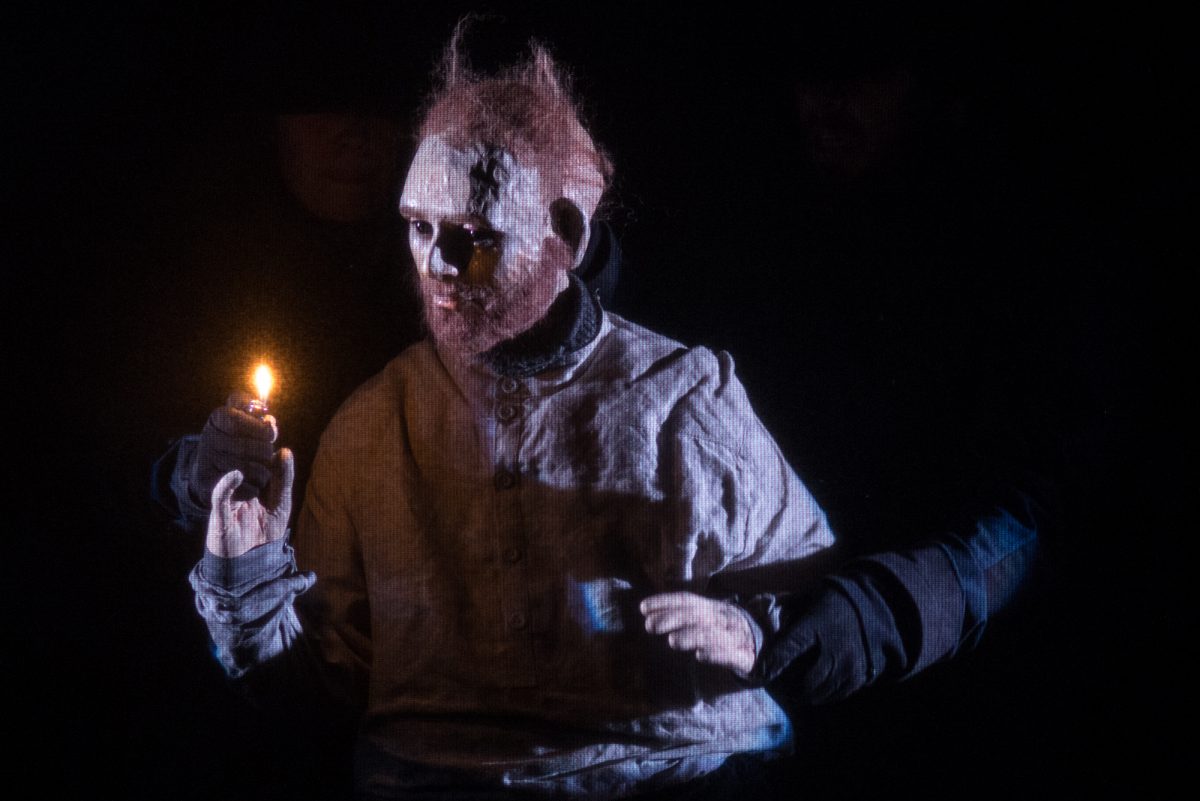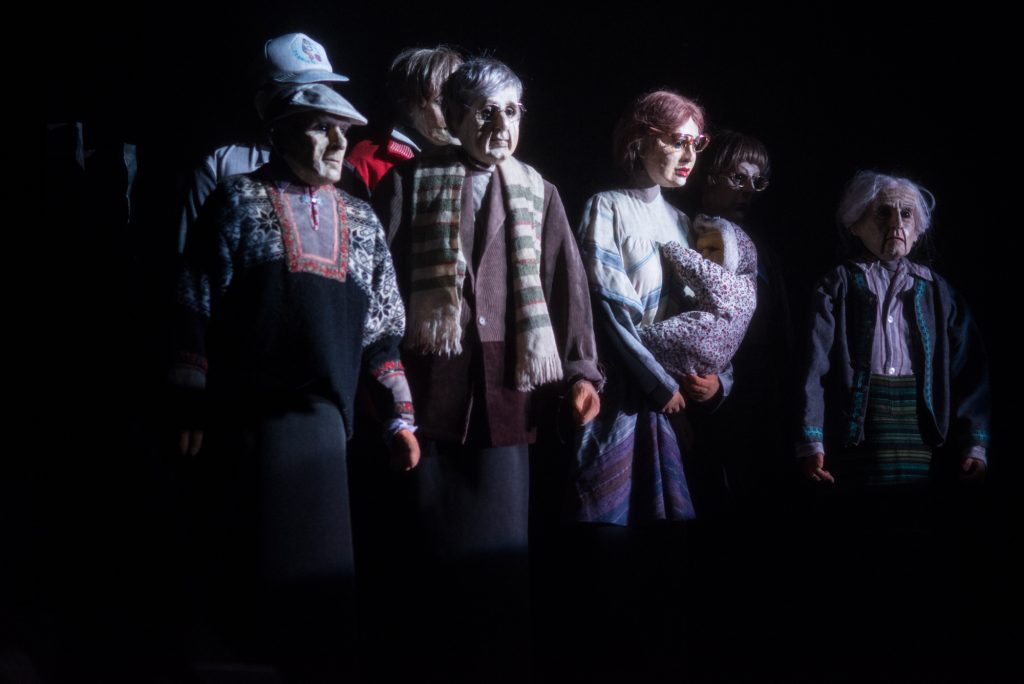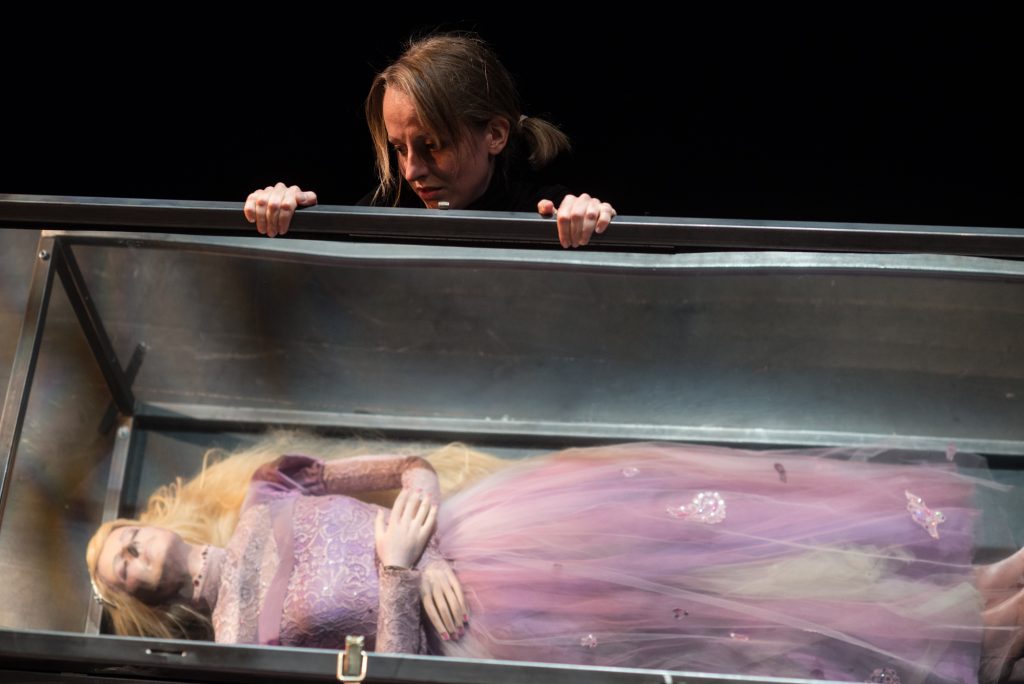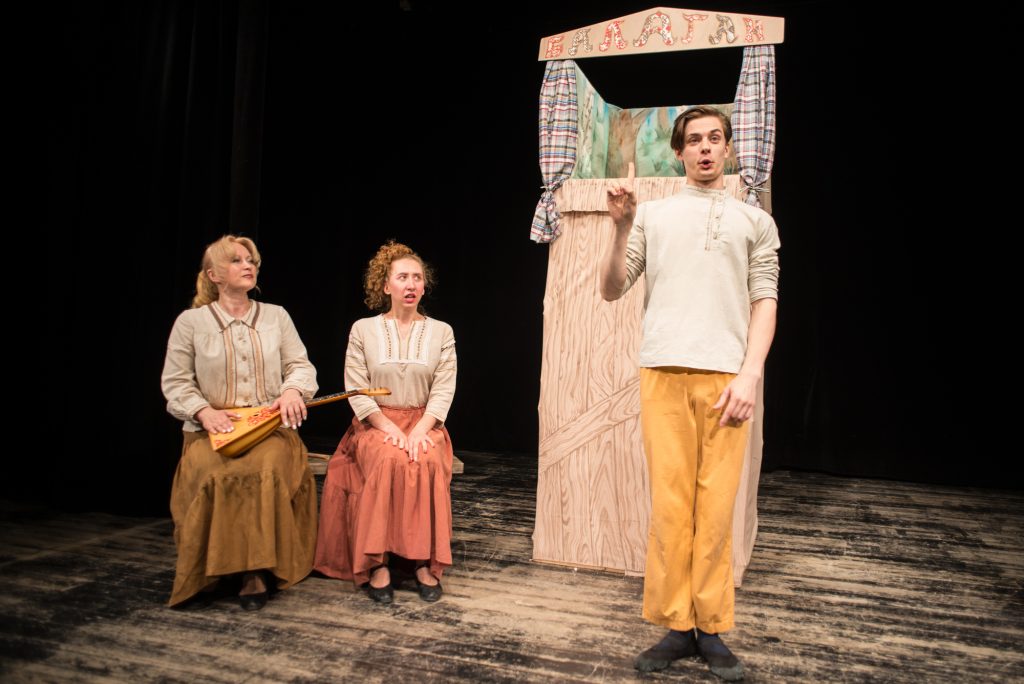KLASYKA WIECZNIE ŻYWA
Idziesz ulicą i nagle twoją uwagę przykuwa mała czerwononosa pacynka z żabim głosem. Podchodzisz bliżej aby zobaczyć parawanowy teatrzyk lalkowy bazujący na spontaniczności i folklorze. Państwowy Instytut Teatralny w Nowosybirsku pokazał nam jedną z najdawniejszych forma teatru lalek, a mianowicie teatr rękawiczkowego bohatera popularnego, sięgający swymi korzeniami XVIII wieku.
Pietruszka – rasowy rozbójnik awanturujący się razem ze swoim największym argumentem, czyli drewnianą pałka, przemierzając świat spotyka i zabija wszystkich na swojej drodze. Byłem świadkiem wciągającej ludowej farsy przeniesionej z rosyjskich ulic, placów i skwerów sprzed dwóch stuleci. Aktorzy połączyli tradycyjny teatr pacynkowy ze współczesnością, parodiując przy okazji elementy innych spektakli festiwalu np. motyw głupich malinek z pokazu „Przebiegłego lisa” studentów z Kijowa. Bezczelny i zawadiacki bohater bawił utrzymując nieprzerwanie uwagę widza, a aktorzy wykorzystywali publikę do rozwiązywania jego problemów. Mimo, że spektakl grany był w języki rosyjskim, artyści co chwila podrzucali słowa-klucze w języku polskim, co pomagało w zrozumieniu akcji. Choć postać Pietruszki ma już swoje lata, i wydawać by się mogło, że estetyka pokazu niekoniecznie odpowiada naszym dzisiejszym gustom, to jednak lekka i farsowa forma się obroniła, a jej rubaszny żart wciąż wywoływał uśmiech na twarzach publiczności. To była ostatnia prezentacja w nurcie pokazów studenckich. Dobra pointa całego Festiwalu
Oliwer Witek
WSPÓŁCZESNA KOBIETA
„Ja dostaję opierdol, tracę pracę, zalegam z czynszem, a ty śpisz” powiedział Kopciuszek do Śpiącej Królewny. Spotkał ją w lesie, leżącą w trumnie. Ze sceny padły słowa, że sytuacja wygląda tak, jakby została wyjęta ze szwedzkiego kryminału. Czy „Pobudka” to kolejna bajka dla małych dziewczynek? Zdecydowanie nie. To historia o rzeczywistości wtłoczona w baśniowy las, w którym telefon komórkowy nie ma zasięgu, są za to bohaterowie z naszych ulubionych opowiadań.
Natalia Sakowicz w autorskim spektaklu zmierzyła się z często dziś poruszanym tematem feminizmu i pozycji kobiety we współczesnym świecie. Kim jest dzisiaj księżniczka? Kobietą, lalką, matką, nienarodzoną córką, aktorką, obiektem pożądania, a może wszystkim naraz?
Kopciuszek nie pędził na bal, lecz na rozmowę o pracę. Kiedyś spotkanie z księciem miało za zadanie polepszyć pozycję społeczną młodej dziewczyny. W tej bajce nie było jednak księcia. Jego miejsce zajął szef, dla którego młoda aktorka musiała się ładnie ubrać, umalować, uczesać i najlepiej pokazać dekolt i nogi. Głowa manekina spytała publiczność, co sądzi o wyglądzie skromnej Natalii Sakowicz ubranej w czarny golf. Choć nikt z widowni nie miał odwagi się odezwać, to na co dzień ludzie nie boją się krytykować wyglądu innych. Taki jest świat. „Wszystkie kobiety muszą się uśmiechać! Śpiąca nawet śpi w uśmiechu”. Długie blond włosy, różowa bufiasta sukienka, śnieżnobiała cera. Czy to nadal archetyp piękności? Czy małe dziewczynki dalej kochają Królewny i chcą być takie jak one?
Najmłodsza i najbardziej niewinna postać to Czerwony Kapturek ukazany jako mała lalka stolikowa. Przed sobą ma całe życie, jest jak czyste jeszcze płótno, zabawka, którą można łatwo manipulować. Pełna zaufania trafia w łapy groźnego Wilka, jedynej samczej postaci, która pojawiła się w spektaklu. W futrzastej masce i rękawicach zakończonych pazurami był nie tylko pedofilem, ale też amatorem kobiecych kształtów atrakcyjnego półmanekina, erotycznie wijącego się w klatce.
W bajce nie mogło zabraknąć też Baby Jagi. Współczesna jest po prostu zgorzkniałą starszą kobietą, która wybrała karierę, a nie macierzyństwo – i ta scena pokazała nowe spojrzenie na temat feminizmu. Z jednej strony kpiła z „młodych saren” biegających po lesie w rytm piosenki „Oops!… I did it Again” popularnej amerykańskiej wokalistki, z drugiej doceniała fakt, że każda dziewczyna jest inna. „Jedna lubi paski, druga kropki, inna karate i to jest dobre. Każdy z nas ma przecież takie samo prawo słuchać Britney Spears, Pink Floydów, Bacha, czy Tiny Turner”. I niech właśnie to zostanie z nami po obejrzeniu Pobudki. Każda z nas jest inna, każda jest piękna i każdy ma wpływ na swoje ciało i życie.
Karolina Pawłoś
OGIEŃ W GŁOWIE, OGIEŃ W TRZEWIACH
Jako ostatni punkt festiwalu zamiast fajerwerków, oglądaliśmy petardę sceniczną – „Popioły” grupy Plexus Polaire. Reżyserka, Yngvid Aspeli, zbudowała poetycki, poruszający spektakl, wykorzystując powieść Gaute’a Heivolla o norweskim podpalaczu. Historia przybrała wymiar uniwersalny, a może nawet metafizyczny, bo byliśmy świadkami próby odpowiedzi na pytanie – jak w każdym z nas rezonują osobiste demony? I czym one są – nieodłącznym elementem nas samych czy duchem, którego jesteśmy w stanie przegnać?
Wilk, który był potężnych rozmiarów lalkową formą, nieustannie czaił się w ciemności. Gdy decydował się wyjść, wyłaniały się jego ogromne, z długimi pazurami łapy, a wgłębienia w masce podkreślał cienki snop światła. Zaatakował Daga, podpalacza, gdy zadano pytanie – „Kogo widzi się, gdy widzi się siebie?”. Uosabiał zatem postać Daga oraz demona pchającego go ku zadawaniu śmierci i samodestrukcji. Wilk nie jedyny nawiedzał postać. Były też duchy ofiar, które (jak on sam) w Popiołach przedstawiono jako manekiny – choć w pierwszej części spektaklu postaci były stolikówkami. Formy te zostały wykonane tak realistycznie, że w pierwszej chwili można mieć wątpliwość, czy nie są żywymi aktorami. Ofiary wychodziły z mroku i znikały tak szybko, jak kolejne ulatujące myśli czy wspomnienia. Dag siedział w fotelu (obok stał czerwony kanister z benzyną) i bacznie przyglądał się zjawom. Jego spojrzenie przebijało mrok i ogarniało całą widownię. Historia „Popiołów” powoli układała się w całość.
Prowadzenie głównej nici narracyjnej przypadło pisarzowi. W tym samym roku, kiedy przyszedł na świat, doszło do serii podpaleń. Dla jego najbliższych, pożar stał się narzędziem do opisywania zastanej rzeczywistości – tam była kiedyś stodoła, gdzie indziej dom. Śledziliśmy, jak w trakcie pracy pisarz wgłębiał się w swoje wspomnienia, jak coraz bardziej analizował własne postępowanie, pęd ku samozagładzie – zamierzone niezdanie egzaminów, alkoholizm, okłamywanie ukochanego ojca. Ostatecznie wnikając w swoją tkankę myślową i sposób myślenia piromana, zaczął się z nim utożsamiać. Widać to było w scenie walki, gdy oboje ściśle ze sobą połączeni, toczyli zaciekły bój na podłodze. Lecz pisarz tę walkę przegrywa, a Dag przejmuje nad nim kontrolę.
Spektakl Plexus Polaire jest arcydziełem technicznym, nie ma tu miejsca na pomyłki czy niedopracowane szczegóły. Ten perfekcjonizm przejawia się we wszystkich elementach pokazu, lalkach i pomysłach na ich animację. Manekiny stały się duchami, wspomnieniami wypełzającymi co chwila z mroku. Z kolei lalki stolikowe – wprowadzane w bardzo prosty, ale pomysłowy sposób – wyobrażały pozostałe postaci pojawiające się w powieści. Między sceną a widownią rozwieszono dodatkowo przezroczystą tkaninę, na której wyświetlano teksty-komentarze. Napisy w połączeniu z pojedynczymi sekwencjami okazały się być idealnym zabiegiem pozwalającym scalić przewijające się wątki – ukonstytuować miejsce akcji, wrócić do poprzedniego wydarzenia, czy też wprowadzić kolejne poziomy narracji.
„Popioły” są spektaklem, który nie pozwala o sobie łatwo zapomnieć. Jego uniwersalny wymiar powoduje, że nie jesteśmy w stanie odpędzić się od kolejnych, zadawanych sobie pytań.
Aleksandra Sidor
CLASSICS – ALWAYS ALIVE
You walk the street and suddenly your attention is caught by a little red-nosed hand puppet with a froggy voice. You go closer in order to watch a screen puppet theatre basing on spontaneity and folklore. Novosibirsk State Theatre Institute presented one of the oldest forms of puppet theatre, that is a popular character known from the XVIII century.
Petrushka – a robber arguing together with his greatest argument – a wooden stick. While wandering through the world, he kills everybody he meets on his way. I witnessed an indulging folk farce transferred from Russian streets and squares of the XVIII century to our modern reality. The actors linked traditional hand puppet theatre with contemporaneity and also impersonated the elements of other performances from the festival, e.g. the motif of stupid raspberries from the presentation of „The Tricky Fox” of the students from Kyiv. Arrogant and cheeky character amused the public by drawing their attention all the time, and the actors used the spectators to help them by solving Petrushka’s problems. And in spite of the fact that the performance was played in Russian language, the artists used Polish key-words to help us understand the gist of action. And although the character of Petruschka is quite old, and it might seem that its aesthetics does not satisfy our modern tastes, it actually defends itself in this farce-like and light convention and its crude humor evoked laughter among the audience. It was the last presentation prepared by the students. Good finale of the whole Festival.
Oliwer Witek
CONTEMPORARY WOMAN
”I am ballocked, I lose a job, I can’t pay the rent, and you just sleep” said a Cinderella to the Sleeping Beauty. They met in the woods, and the Sleeping Beauty was lying in the coffin. The words coming from the scene sounded as if they were taken from the Swedish crime story. Is „Rise and Shine” another fairy tale for girls? Certainly not. This is a story from reality transferred into a fairy forest, where a mobile phone does not work, but the characters from our favorite tales appear.
Natalia Sakowicz in her author performance tried to face with the theme of feminism and the position of a woman in a modern world. Who is a princes today? A woman, a puppet, a mother, an unborn daughter, an actress, the object of desire, or everything at once?
Cinderella did not haste to a ball, but rather a job review. Once upon a time, the meeting with a prince was to improve young girl’s social position. However, in this story, there is no prince. He was replaced with a boss, for whom a young actress had to dress nicely, have her makeup and hair done, and show cleavage and legs. The mannequin’s head asked spectators, what they think about the looks of Natalia Sakowicz herself, dressed in black golf. Although nobody had the courage to answer her question, people usually are not afraid to criticize others’ looks in ever-day relations. It is just the world. “Every woman has to smile! Even the Sleeping Beauty smiles during her sleep. Long blond hair, pink dress, snow-white skin. Is it still an archetype of beauty? Do little girls still love Princesses and want to be alike?
The youngest and most innocent character is Little Red Riding Hood presented as a little table puppet. She has all her life in front of her, she is as innocent as blank paper, a toy that is easily manipulated. She looks trustfully at the angry Wolf, the sole male character of the performance. In a mask and gloves ended with claws, he is not only a pedophile, but also an amateur of female shapes of an attractive mannequin, erotically moving in a cage.
There is also a Baba Yaga in this fairy tale. In this modern version, she is a bitter elderly lady who chose career instead of motherhood – and this scene showed a new look at the theme of feminism. On one hand it mocked “young does” running through the woods in a rhythm of “Oops!… I did it again” song of a popular American singer, on the other hand it appreciated the fact that every girl is different.“ One likes dots, the other stripes, or karate and this is good. Each of us has the right to listen to Britney Spears, Pink Floyd, Bach or Tina Turner.” And this fact should stay with us after this performance. Each of us is different, each of us is beautiful and independently influences her own body and life.
Karolina Pawłoś
FIRE IN THE HEAD, FIRE IN THE INTERNALS
Instead of fireworks at the end of the Festival, we received a real theatrical bomb – „Ashes” of Plexus Polaire Group. The director, Yngvid Aspeli, created a poetic, moving performance inspired by the novel written by Gaute Heivoll telling a story of Norwegian arsonist. The story has a universal character, or perhaps even a metaphysical one, because we were witnesses of the attempt to answer the question – how our personal demons resonate in us? And what are they – an indispensable element of ourselves or a ghost that we are able to chase away?
The Wolf – an enormously big puppet form – was waiting continuously in the darkness. When he decided to appear, first his long legs with long claws were to be seen in a beam of light. He attacked Dag and the demon eager to kill and self-destruct. But it was not only the Wolf that visited Dag. There were also the ghosts of victims, who (as well as himself) were introduced as mannequins in „Ashes” – although in the first part of the performance the characters were presented as table puppets. The forms were so realistically prepared that at first it was not easy to recognize whether they were not real actors. The victims came out of the darkness and disappeared as quickly as thoughts or memories. Dag was sitting in an armchair (next to him a red canister with petrol) and looked closely at those phantoms. His look covered the whole audience. The story of „Ashes” was slowly developing into an understandable story.
The act of leading the main thread of narration was given to a writer. The same year he was born, there were a series of arsons. For his family, the fire became a tool to describe the observed reality – there was a barn once, somewhere else the was a house. We followed, how during his work he tries to understand his own memories, how he analyzed his own behavior, his chase towards destruction – planned failure during exams, alcoholism, lying to his beloved father. Finally, he started to act just as the arsonist by entering into his thoughts. It is clearly visible in the scene of the fight, when both of them are attached to each other and fight against each other on the floor. The writer loses the battle, and Dag takes control over him.
The performance of Plexus Polaire group is a technical masterpiece, there is no place for mistakes or imperfections. It is visible in all elements of the performance, in puppets and animation solutions. Mannequins became ghosts, memories coming out from the darkness. And table puppets – introduced in a very simple, but interesting way – were presented as characters from the novel. Between the stage and the audience, there hanged a transparent material, on which the texts – commentary was projected. The commentary plus individual sequences were a perfect solution to integrate intertwining plots – to settle a place of action, return to a previous situation or to introduce the next levels of narration.
„Ashes” is a performance that does not allow to forget about itself easily. Its universal dimension causes that we are not able to ward off questions, which keep coming back.
Aleksandra Sidor
Fot. Tobiasz Czołpiński



